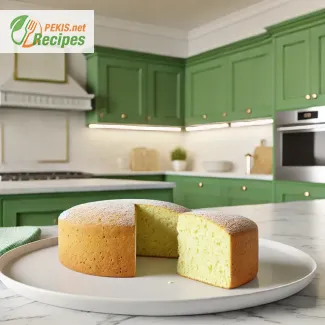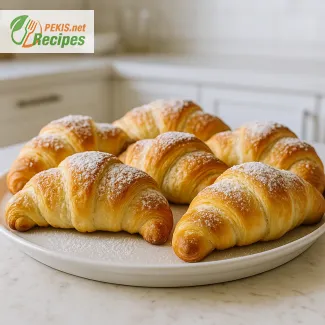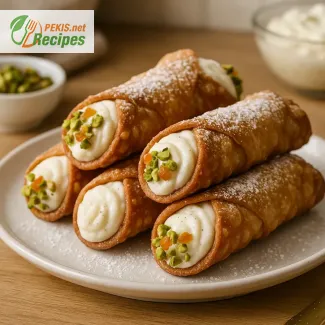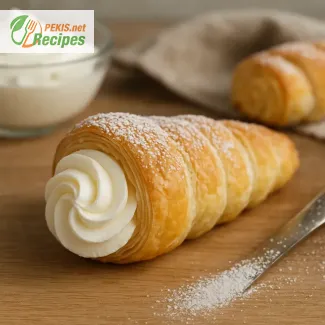
The gluten-free cake biscuit is a light and airy base that opens up a world of possibilities for dessert creations. This gluten-free foundation allows anyone, from professional bakers to enthusiastic home cooks, to enjoy the classic texture and taste of traditional sponge cakes without the inclusion of gluten. Ideal for layer cakes, trifles, roulades, or simply enjoyed on its own, this biscuit is a must-have for those pursuing gluten-free options without compromising on flavor or texture. The beauty of a gluten-free cake biscuit lies in its adaptability; with the right preparation techniques, it can become the highlight of an impressive dessert display.
Ingredients and Taste
Crafted with carefully selected gluten-free flours, such as rice flour, almond flour, or even coconut flour, this cake biscuit balances moisture and structure. Unlike some gluten-free baked goods that can turn dense or dry, this recipe maintains a moist and tender crumb. A blend of flours often works best, giving it the stability to rise while still achieving that delicate, airy texture. The flavor is subtly sweet, making it the perfect base to pair with almost any filling or frosting, from rich chocolate ganache to zesty fruit preserves.
The use of baking powder and eggs gives this cake its characteristic fluffiness and helps it to hold up well even with gluten-free flour substitutes. High-quality vanilla extract and a hint of lemon zest can enhance its natural flavor profile, making the biscuit deliciously fragrant. This gluten-free cake biscuit is both versatile and mildly sweet, an excellent canvas that allows the flavors of your choice to shine through.
Preparation Tips and Techniques
Achieving the right texture in a gluten-free cake biscuit requires some mindful steps in preparation. Due to the absence of gluten, which typically gives traditional cake its elasticity, this cake relies on the right balance of ingredients and techniques:
- Whip the Egg Whites Separately: To give the biscuit a light, airy texture, it’s helpful to whip the egg whites separately before gently folding them into the batter. This technique helps in adding volume and lightness.
- Avoid Over-Mixing: Gluten-free flours do not benefit from over-mixing; it can break down the structure and result in a dense cake. A light hand while mixing the batter is essential to maintain the desired soft texture.
- Let the Batter Rest: Allowing the batter to sit for a few minutes before baking can help the flours absorb moisture, resulting in a more consistent crumb.
- Even Baking: Using a lower oven temperature and baking the cake on a central rack prevents it from browning too quickly on the outside while leaving the center undercooked. This is particularly important for gluten-free cakes, as they tend to be more delicate.
Preparation in Advance
This gluten-free cake biscuit can be prepared one to two days in advance without losing its freshness. Simply allow the cake to cool fully before wrapping it tightly in plastic wrap or an airtight container to lock in moisture. For longer storage, freeze the cake layers for up to a month. To do this, wrap each layer individually in plastic wrap, followed by a layer of aluminum foil, and place them in a freezer-safe bag or container. When you’re ready to use the biscuit, thaw it in the refrigerator overnight, and it will retain its delightful texture and flavor.
Serving Suggestions
For a luxurious and professional dessert, consider using this gluten-free biscuit as a base for a layer cake with decadent fillings. It pairs wonderfully with:
- Chocolate ganache for a rich, intense flavor.
- Vanilla buttercream for a classic and balanced sweetness.
- Fresh berries and whipped cream for a light, summery dessert.
- Lemon curd or fruit compote for a refreshing contrast.
This gluten-free biscuit can also be cut into shapes for petit fours or individual servings, making it perfect for both casual gatherings and formal occasions. Simply dust with powdered sugar or drizzle with a glaze for an elegant finish.
Storage Recommendations
To keep the cake fresh and flavorful, it’s crucial to store it properly:
- Short-Term Storage: If planning to use the cake within a couple of days, store it at room temperature in an airtight container. This keeps it moist and flavorful. Avoid refrigerating the cake, as it may dry out faster in the fridge.
- Long-Term Storage: For longer storage, freezing is the best option. As mentioned earlier, wrap each layer carefully in plastic and foil before placing it in the freezer. When you’re ready to assemble and serve, let the layers thaw slowly in the refrigerator to prevent condensation from making the cake soggy.
A Dessert That Embraces All Diets
Beyond its delightful texture and adaptability, this gluten-free cake biscuit appeals to those following gluten-free diets, whether due to Celiac disease, gluten sensitivity, or simply a lifestyle choice. The fact that this cake is gluten-free doesn’t mean it lacks in flavor or texture; it’s a delicious option that everyone at the table can enjoy, making it a popular choice for gatherings with varied dietary needs. The biscuit’s versatility ensures that it’s a dessert base you’ll reach for time and time again, as it meets the needs of diverse diets while delivering a delicious result.
In short, this gluten-free cake biscuit is the foundation you need to create beautifully layered cakes, sophisticated desserts, or simple tea-time treats. With the right care in preparation and storage, it’s a cake base that can be enjoyed fresh, light, and flavorful, adding elegance to any occasion.
- Preheat the Oven: Set the oven to 180°C (350°F). Line a 20 cm (8-inch) round cake pan with parchment paper and lightly grease the sides.
- Prepare the Dry Ingredients: In a medium bowl, sift together the rice flour, almond flour, cornstarch, baking powder, and salt. Mix until evenly combined. This helps create a lighter texture for the cake.
- Separate the Eggs: Separate the egg whites and yolks. Place the whites in one large mixing bowl and the yolks in another.
- Whisk the Egg Yolks: Add the sugar and vanilla extract to the bowl with the yolks. Whisk the mixture for about 3 minutes, or until it becomes pale and creamy. Set aside.
- Whip the Egg Whites: Using a clean, dry mixer, whip the egg whites on medium speed until soft peaks form. Gently fold the whites into the yolk mixture using a spatula, ensuring not to deflate the whites.
- Incorporate the Dry Ingredients: Gradually sift the dry ingredients into the egg mixture, folding gently after each addition. Avoid overmixing to keep the batter light and airy.
- Bake: Pour the batter into the prepared pan, smoothing the top with a spatula. Bake in the preheated oven for 20-25 minutes or until a toothpick inserted into the center comes out clean.
- Cool and Serve: Allow the cake to cool in the pan for 10 minutes, then transfer it to a wire rack. This gluten-free biscuit can be served immediately or stored for later use.
This gluten-free cake biscuit can be prepared and stored for various uses, making it a versatile addition to any glutThe gluten-free cake biscuit recipe presents a balanced approach to creating a satisfying dessert while addressing specific dietary needs. While this recipe may seem light in caloric content compared to other desserts, its ingredients contribute essential nutrients that impact various aspects of health. Here, I’ll discuss how each primary component, as well as the overall nutritional profile, influences the body, emphasizing the role of vitamins and minerals found in this dessert. Lastly, I’ll provide general guidelines on how often this dish could appear in a healthy diet, along with extra advice to enhance its nutritional benefits.
Nutritional Breakdown and Health Impact of Ingredients
- Rice Flour
Rice flour serves as the primary base in this recipe and is naturally gluten-free. It is also a source of B vitamins, particularly niacin (B3) and thiamine (B1), which are essential for energy metabolism and maintaining the health of the nervous system. Although rice flour doesn’t offer high protein content, it provides fiber to aid digestion. However, unlike whole grains, rice flour can be lower in fiber and certain minerals, so pairing this dessert with fiber-rich foods, like berries, can create a more balanced meal. - Almond Flour
Almond flour is a nutrient-dense ingredient, providing not only a nutty flavor but also vitamin E, magnesium, and healthy fats. Vitamin E is a potent antioxidant that supports skin health, helps combat oxidative stress, and strengthens the immune system. Magnesium in almond flour contributes to muscle and nerve function, as well as energy production. The healthy fats in almond flour are primarily monounsaturated fats, known to benefit heart health by supporting healthy cholesterol levels. Almond flour also contains protein and fiber, adding to the satiety factor of this dessert. - Cornstarch
Cornstarch is used to lighten the texture of the cake, making it fluffy and tender. While cornstarch is mostly carbohydrates and low in vitamins and minerals, it provides a quick source of energy, making this dessert ideal for a light snack that won’t heavily impact blood sugar when consumed in moderation. For those looking to add more nutritional value, cornstarch could be substituted with chickpea flour or arrowroot powder, which add extra fiber and trace minerals. - Eggs
Eggs are an integral part of this recipe, acting as a binding and leavening agent. They are rich in protein and essential amino acids that support muscle growth, tissue repair, and overall bodily functions. Additionally, eggs contain vitamin D, which supports bone health, and B vitamins like B12 and riboflavin (B2), essential for energy metabolism and red blood cell production. Choline, found in eggs, is another crucial nutrient, supporting brain health, memory function, and liver function. Including eggs in this recipe makes it a valuable source of protein in a dessert, which also enhances the texture and structure of the cake biscuit. - Sugar
Sugar contributes to the sweetness and caramelization in this cake biscuit. While it provides immediate energy, sugar lacks substantial vitamins or minerals. In moderation, sugar can be enjoyed as part of a balanced diet, but it’s essential to limit excessive intake, as overconsumption can lead to spikes in blood sugar levels and has been linked to various metabolic health concerns. Reducing the amount of sugar or substituting part of it with natural sweeteners, like honey or maple syrup, can offer a slight boost in micronutrients and antioxidants. - Baking Powder
Baking powder is a leavening agent that helps give the cake its light, airy texture. It does not add significant nutrients, but it’s low in sodium, making it suitable for various dietary needs. - Vanilla Extract
Vanilla extract is used to enhance flavor and aroma without adding substantial nutritional value. Natural vanilla extract, however, does contain trace amounts of antioxidants that help protect cells from oxidative stress. - Salt
A small amount of salt is used in this recipe to enhance the flavors. Salt is primarily composed of sodium, an essential mineral that supports nerve function, muscle contraction, and fluid balance. Keeping the amount of salt low in a recipe like this allows it to complement the flavors without impacting sodium levels excessively.
Health Benefits of Key Nutrients
- Vitamin E (from almond flour): Vital for skin health, cellular protection, and immune support. As an antioxidant, it neutralizes free radicals that can lead to cellular aging.
- B Vitamins (from rice flour and eggs): These vitamins are essential for energy production, cognitive health, and the formation of red blood cells. B vitamins, particularly B12 and B2, also support metabolic processes that help convert food into usable energy.
- Magnesium (from almond flour): Essential for muscle function, nerve transmission, and relaxation. Magnesium also plays a role in heart health and is known to help manage stress and improve sleep quality.
- Protein (from eggs and almond flour): Provides a complete set of essential amino acids necessary for muscle repair, immune function, and hormone regulation. Including protein in a dessert can help balance blood sugar levels and add a level of satiety.
- Fiber (from rice flour and almond flour): Fiber is essential for digestive health, helping to regulate bowel movements and support healthy gut bacteria. Fiber can also help control blood sugar levels, which makes this dessert a healthier choice compared to sugar-heavy options.
How Often to Include This Dish in Your Diet
Given its nutritional profile, the gluten-free cake biscuit can be an enjoyable addition to a balanced diet, especially for those following gluten-free lifestyles. However, because it is still a dessert with added sugar, moderation is essential. Including it once a week or during special occasions can be a suitable approach for maintaining a balanced intake of sweets. Pairing it with fiber-rich toppings, like berries or a dollop of Greek yogurt, can improve its nutritional density and reduce the likelihood of sugar spikes.
General Advice for Enhancing the Recipe’s Nutritional Value
- Incorporate Fresh Fruits: Adding a layer of fresh berries, such as blueberries, strawberries, or raspberries, not only complements the cake’s flavor but also increases the intake of antioxidants, vitamin C, and additional fiber.
- Experiment with Natural Sweeteners: Substituting a portion of sugar with natural sweeteners like maple syrup or honey can add a more complex flavor while providing trace nutrients, such as manganese and zinc from maple syrup. However, be cautious as these are still forms of sugar and should be used in moderation.
- Add a Yogurt-Based Topping: A light yogurt-based topping can increase the calcium and probiotic content of the dessert, supporting bone health and gut health. Use Greek yogurt for extra protein, and add a hint of vanilla or lemon zest for flavor without excess sugar.
- Mind Portion Control: Although this dessert is gluten-free, it’s still calorie-dense, so being mindful of portions is essential. Cutting smaller slices or pairing it with fresh fruit can make the meal feel more substantial while providing a more balanced nutrient intake.
- Alternative Flours for Extra Fiber: For those looking to boost fiber intake, try replacing a portion of the rice flour with oat flour or quinoa flour. Both options provide more fiber and some additional protein, making the cake more satisfying and nutritious.
- Substitute Fats Wisely: If you wish to further reduce calories, consider swapping a portion of the almond flour with additional rice flour or using a bit of applesauce for added moisture. This can reduce the fat content while still keeping the biscuit soft and fluffy.
This gluten-free cake biscuit is a delightful and versatile dessert that can cater to dietary restrictions without sacrificing flavor. With its balanced mix of fiber, healthy fats, and proteins, this cake biscuit can satisfy cravings in a more nutritious way compared to traditional gluten-based desserts. By including it in moderation and exploring nutrient-rich toppings or minor substitutions, this recipe can easily fit into a balanced diet, offering not only flavor but also essential nutrients for overall health.en-free baking repertoire.
- Eggs: This recipe contains eggs.
- Nuts: Almond flour is used, which may not be suitable for those with nut allergies.
Substitution Tips for Allergens
- Egg-Free Option: Replace each egg with ¼ cup (60 ml) of applesauce or a mixture of 1 tbsp ground flaxseed + 3 tbsp water (per egg), letting it sit for a few minutes to thicken before adding.
- Nut-Free Option: Substitute almond flour with an equal amount of gluten-free oat flour or additional rice flour for a nut-free version.





